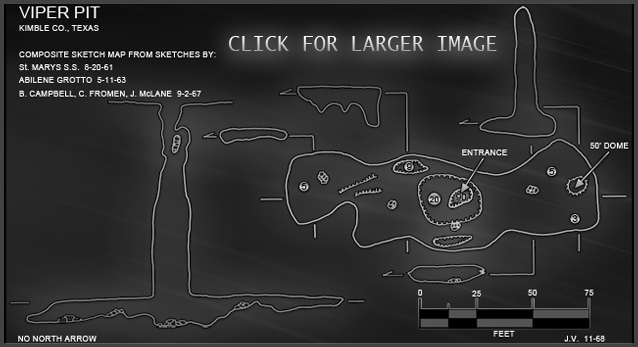
|
Description: The pit entrance is 2.5 ft in diameter and located beside a small draw. The
entrance drop continues approximately the same size irregularly for about 20 ft to a small ledge about a foot wide and a small contristion before opening out
to about 10 feet wide for the remainder of the 90 ft frop. Active flowstone covers about half the circumferance of the pit from about 25 ft down to the
bottom. The drop ends in an elongate room about 135 ft long, 30-45 ft wide and 4-8 ft high. At one end of the room is a 50 ft dome. Guano-covered
breakdown occupies most of the floor exceot under the entrance drop where water falling has created a small depression with travertine-coated logs. Chert
layers are prominent in the walls of the room. The map of Viper Pit is a composite of sketches by the the seprate exploration groups.
History:
The cave was probably explored by Joe Gardener about 1914. Prior to explotration by irganized groups, the cave was occasionally enterd by local people to
obtain guano. Mr. Allison had entered the cave about 1953 for that purpose, but apparently no one had enterd the pit between that time and 1961. On 20
August 1961, a group of St. Mary's Speleological Society cavers, including Orion Knox, Preston Knodell, his girl Mary, Gabby and Barbara Madden located the
cave. Barbara ebtered the cave but was frightened by a snake at the bottom. Orion Knox entered and found a striped snake and a coachwhip. The enterance
was visted by George Gray, James Estes and Bryant Lilly of the Abilene Grotto on 20 April 1963, but they had insufficient equipment for the drop. Gery,
Estes and Bart Crisman retrnued May 11 to explore the cave. Crissman and Estes killed a 6 ft long snake ressembling a copperhead. They also reported
crickets, scorpions, a large green frog and thysanurans. The pit was again explored and sketch-mapped during the TSA Region Project by Bill Campbell, Jim
McLane and Charles Fromen on 2 September 1967.
Go to the photo gallery page to view more pictures of the bat cave.
|